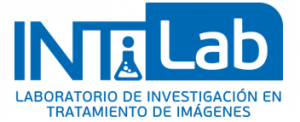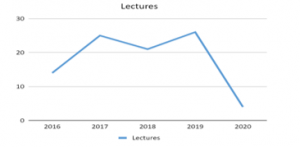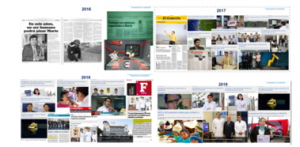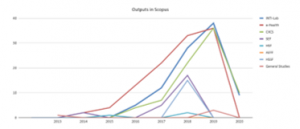Promotion of the Research Activities at the Image Processing Research Laboratory (INTI-Lab) of the UCH as Knowledge Management Strategy
Volume 5, Issue 3, Page No 563-567, 2020
Author’s Name: Avid Roman-Gonzalez1,2,a), Natalia Indira Vargas-Cuentas1
View Affiliations
1Image Processing Research Laboratory (INTI-Lab), Universidad de Ciencias y Humanidades, 15834, Peru
2Business on Engineering and Technology (BE Tech), 15076, Lima, Peru
a)Author to whom correspondence should be addressed. E-mail: avid.roman-gonzalez@ieee.org
Adv. Sci. Technol. Eng. Syst. J. 5(3), 563-567 (2020); ![]() DOI: 10.25046/aj050370
DOI: 10.25046/aj050370
Keywords: Knowledge management, INTI-Lab, Research assessment, Research promotion, Research achieves
Export Citations
In Peru, approximately since 2013, a necessary change has begun in the importance given to research, science, technology, and technological innovation. Likewise, in 2014, a new University Law was approved that among other aspects also promotes research production in universities. Against this context, the universities begin to improve with more emphasis activities related to research. The Universidad de Ciencias y Humanidades creates different research centers, one of them being the Image Processing Research Laboratory (INTI-Lab). Through INTI-Lab research projects are generated both with own resources and through external financing sources. INTI-Lab helps to increase the number of papers published and indexed in SCOPUS, increase the score in Researchgate platform, improve the position on the Webometrics ranking, and brings students closer to the research activity. In this context, a Knowledge Management strategy is essential. In the present work, an analysis of the different strategies and results will be presented. The analysis shows that the knowledge management strategies adopted by INTI-Lab contribute to increase the scientific production of the UCH.
Received: 08 April 2020, Accepted: 22 June 2020, Published Online: 26 June 2020
1. Introduction
The Peruvian government, through the National Council of Science, Technology and Technological Innovation (CONCYTEC for its acronym in Spanish) since about 2013 have begun the implementation of some policies that encourage the research activities oriented to solve real problems of society. These actions include contest funds for the development of postgraduate studies, conducting research stays, financing for research projects, financing for scientific equipment, funding for the organization of technological events, incentives for the publication of scientific articles, tax incentives for companies that invest in science and technology [1].
On the other hand, the Ministry of Education of Peru, through the National Superintendency of Higher Education (SUNEDU for its acronym in Spanish) has been performing the licensing of the universities that meet the Basic Conditions of Quality (CBC for its acronym in Spanish) [2].
Faced with this promising context for research, fostered by the policies described above, universities have increased the recruitment of researchers to increase scientific production.
The Universidad de Ciencias y Humanidades (UCH), in this context, could not be left behind. The UCH began its academic activities in 2008, its headquarters are located in Los Olivos district, Lima, Peru. UCH currently has ten professional schools and provides service to more than 3000 students. The UCH obtained the SUNEDU license in November 2017.
The UCH on the subject of research has made a substantial investment to promote the development of research projects and increase scientific production [3]. This investment includes the creation of 3 research centers: e-Health (created in 2014), a research center that focuses on the subject of health sciences and is related to the professional school of nursing. CIICS (created in May 2016), an interdisciplinary research center focused on social and economic issues, related to professional schools of initial education, primary education, accounting, psychology, marketing, and administration. INTI-Lab (created in June 2016), a research center focused on the application of engineering to solve real problems of society, related to the professional schools of Systems Engineering, Electronic Engineering, and Industrial Engineering.
Likewise, the UCH promotes formative research in its undergraduate students through 3 programs that are developed throughout the five years of study of each professional school [4].
All these mentioned actions have allowed the UCH to improve positions in different rankings based on research such as those presented in [5, 6]. Taking the described situation into account, a good knowledge management strategy is necessary to maintain achievements and continue to improve.
Different authors know knowledge management (KM) as a fundamental strategy for companies in this contemporary situation [7, 8]. The KM plays a pivotal role in the competitiveness of large firms and small and medium enterprises [9] due to different strategies for conserving, passing, and continuing the organization strategy regardless if there are changes in the personal resources.
The present work continues as follows: Section II presents the Image Processing Research Laboratory (INTI-Lab), its creation and its research topics, as well as its members. Section III shows the different achievements obtained by INTI-Lab since its establishment and the Knowledge Management strategy applied in INTI-Lab. Finally, Section IV presents the analysis and conclusions of the results.
2. Image Processing Research Laboratory (INTI-Lab)
The Image Processing Research Laboratory (INTI-Lab for its acronym in Spanish) is one of the three research centers of the UCH. The acronym was chosen due to INTI means Sun in Quechua, Quechua is the mother language of INCAS (pre-Spanish culture in Peru), and Sun was considered a God in the INCAS culture. INTI-Lab was created on June 23, 2016, through Resolution No. 090-2016-CU-UCH. INTI-Lab is a research center dedicated mainly to the development of projects related to the signal and image processing, aerospace technology, rehabilitation engineering, smart cities, ICT, biotechnology, development of electronic systems, computer systems and artificial intelligence.
The main objective of INTI-Lab is to contribute to the generation and growth of research production at the Universidad de Ciencias y Humanidades, both at the professor level and at the student level, developing research projects that can help to solve real problems of our society.
INTI-Lab has principally six research topics that are:
Electronic Circuits and Communication Systems.
- Computing Systems and Computer Science.
- Industrial Applications
- Engineering in Medicine and Biology
- Aerospace systems
- ICT Management
At its beginning, INTI-Lab was created with only one member, in 2017 INTI-Lab go to 12 members, in 2018, 11 members, and currently, INTI-Lab has 15 members.
In Figure 1, one can see de logo of the INTI-Lab.

Figure 1: INTI-Lab Logo
3. Achievements and Knowledge Management Strategy of INTI-Lab in the Research Field
Since its creation in June 2016, INTI-Lab has had several achievements among which we can mention:
- First place in the COPROING 2016.
- First and second place in the 1st Conference of Sciences and Humanities (2016).
- Third place in the Science and Humanities Fair 2017.
- First Place in the II Conference of Sciences and Humanities (2017).
- 5 United Nations grants.
- First place in the II Creaton UCH 2018.
- One of our members won a scholarship to pursue a master’s degree in Russia.
- One member won the OHB SE Competition (2018).
- Best paper award in ETCM 2018.
- Five grants for research project development.
- Emerging Space Leader – ESL 2019
- Young Space Leader – YSL 2019
- 8 research grants (international and national)
3.1. Invited Lectures
Part of the research work is to be able to publicize the results of research, not only at the technical level through the publication of scientific articles, but also doing scientific dissemination tasks for the general public through talks. In that sense, in Figure 2, one can observe the evolution of lectures given by the members of INTI-Lab in different years.

Figure 2: Lectures given by INTI-Lab members (collected data at 20/06/2020)
3.2. Press
The works developed in INTI-Lab not only reach the public through published scientific articles, or through the given talks, but also attract the attention of the press, could be written, radio, and/or television. In this sense, since 2016, different members of INTI-Lab have had press appearances giving the results of the developed projects. INTI-Lab projects had press coverages in 2016, 2017, 2018, 2019 and so far in 2020.
In Figure 3, one can see a sample of the different press coverages made to the INTI-Lab projects in 2016, 2017, 2018, and so far in 2019.
 Figure 3: INTI-Lab in press
Figure 3: INTI-Lab in press
3.3. Publications
The publication of scientific articles is one of the final tasks of researchers. The idea is to be able to share the results of the research with the scientific community of the whole world. Whatever the topic one is investigating, let’s be sure that other research groups are working on similar topics. The publication of articles allows us to share results; it can open the possibility of working in groups, sign agreements, make academic exchanges, among other benefits.
Likewise, there are many rankings of universities that take into account the number of published articles. One of these rankings is the one developed by the Scimago group [10].

Figure 4 : Scientifique articles published by INTI-Lab members (collected data at 20/06/2020)
Figure 4 shows the evolution in terms of the number of published papers by INTI-Lab; these data include indexed and non-indexed documents.
3.4. Agreements
An essential part of the work carried out in INTI-Lab are the agreements signed with other national and international institutions. These agreements allow us to develop projects together, the use of technological tools, the ability to carry out academic exchanges, research stays, among other benefits.
The institutions with which INTI-Lab currently has an agreement are the following:
- INICTEL-UNI (Peru)
- Universidad Peruana Cayetano Heredia (Peru)
- Universidad de Malaga (Spain)
- Beihang University (China)
- Universitatea Tehnica Gheorghe Asachi (Romania)
- Peruvian Space Agency (Peru)
- Open Cosmos (United Kingdom)
In Figure 5 one can see the logos of the institutions with which INTI-Lab has an agreement.

Figure 5: Logos of the institutions with which INTI-Lab has an agreement (collected data at 20/06/2020)
3.5. Scientific production of the UCH
The UCH, thanks to its investment in research, has increased its scientific production, which can be seen in Figure 6.

Figure 6: The number of UCH scientific articles indexed in SCOPUS over the years (collected data at 20/06/2020)
This increase has achieved a better positioning of the UCH in different rankings since different rankings are depending on the research. One ranking using metrics based on the web is Webometrics [11]; the performance of the UCH in the Webometrics ranking can be seen in Figure 7.

Figure 7: Progress of the position of the UCH in the ranking developed by Webometrics. In the gray curve and the left vertical axis, one can see the place worldwide. In the curve in blue and the right vertical axis, the position at the national level is observed. (collected data at 20/06/2020)

Figure 8: Evolution of the UCH concerning the ResearchGate Score. (collected data at 20/06/2020)
But the benefits are not only reflected in the ranking but also in the ResearchGate scores as can be seen in Figure 8. ResearchGate is a kind of social network for researchers in which what is shared are scientific articles, thesis, dissertations, posters, books, etc. [12].
3.6. Contribution of INTI-Lab to the scientific production of the UCH
The UCH has different dependencies among which one can mention three research centers (e-Health, CIICS, and INTI-Lab), ten professional schools (electronic engineering, systems engineering, industrial engineering, nursing, psychology, accounting, administration, marketing, primary education, and initial education), and the general studies department. Each of these dependencies, organizing in faculties (Science and Engineering Faculty – SEF, Health Science Faculty – HSF, Accounting, Economics, and Financial Faculty – AEFF, Humanities and Social Sciences Faculty – HSSF, and General Studies), contributes to the total scientific production of the UCH. In Figure 9, one can see the contribution in the number of papers of each unit. It can be seen that the number of documents of INTI-Lab varies concerning what is shown in Figure 2 since, in the case of Figure 9, only the papers indexed in SCOPUS are shown. For the scientific production of the UCH, the analysis is done only taking into account the documents indexed in SCOPUS since they are the ones that count to elaborate the Scimago ranking.

Figure 9 Scientific productions in SCOPUS of the different dependencies of the UCH. (collected data at 20/06/2020)
INTI-Lab being the newest of the three research centers of the UCH presents an essential contribution to the number of papers of the UCH
3.7. INTI-Lab Scientific Tuesday
Knowledge management is essential in any institution to transmit knowledge. In INTI-Lab, knowledge management is vital to continue growing in the indicators mentioned above, regardless of the change of members. At INTI-Lab, as a knowledge management strategy, “INTI-Lab Scientific Tuesdays” have been implemented. These scientific events are days in which the members of the research team (in turn, according to a pre-established schedule) share their progress on the projects that they are developing. These sessions take place once a month. Thanks to this strategy, each member knows and can contribute to the work of others. In Figure 10, one can observe a session of the “INTI-Lab Scientific Tuesday”.

Figure 10: INTI-Lab Scientific Tuesday.
4. Discussion and Conclusion
According to what is presented in Section 3, it can be observed that the contribution of INTI-Lab to the scientific production of the UCH is essential. One can see in Figure 11 that this contribution represents 27.96% of the total scientific output of the UCH throughout the different years.
The contribution of INTI-Lab is only below e-Health, which is the oldest research center of the university. INTI-Lab since its creation has occupied the second place and has been shortening distances with e-Health. For 2019, INTI-Lab go to the first place.
In each of the aspects measured, whether publications, invited lectures, agreements, contests, and grant; the growth of INTI-Lab has been exponential.

Figure 11: Contribution of the different dependencies to the scientific production of the UCH.
INTI-Lab has always tried to work hand in hand with students. So it is the UCH research center with the most significant number of papers whose first author is a student, reaching 17.14% of the total number of articles published by INTI-Lab.
Unlike other places where publication with students is done mainly with postgraduate students, INTI-Lab works with undergraduate students, since the UCH does not yet have a post-grade school. The fact of achieving a good cup of publications with undergraduate students is another aspect to highlight.
In addition to the statistics already mentioned, one can suggest other achievements of INTI-Lab that highlight the promotion of research at the UCH. For example, one of the members of INTI-Lab won a scholarship to do postgraduate studies in Russia. Another INTI-Lab member was recognized as a researcher by CONCYTEC, becoming the first CONCYTEC researcher entirely UCH (UCH student, UCH internship, and currently working at UCH).
On the other hand, the Knowledge Management (KM) must be fundamental in every company, also in startups where the learning curve must be shorter. KM is a differentiating factor. Universities have the main focus of generating knowledge, and one has to design the model or strategy that is needed from what KM means for the university. Patents, scientific articles, as indicators or metrics, can be used. In companies with high capital investments and with significant operational risks (such as companies related to space missions), the KM is essential because an error can cause considerable losses. These losses could be in infrastructure or lives.
The INTI-Lab strategies described in this work contribute to the objective on the research activities at university
- Lastra, Javier Ulises Solis. “Tax Incentive to Promote Research Development and Innovation in Peru.” 2018 IEEE Sciences and Humanities International Research Conference (SHIRCON). IEEE, 2018. DOI: 10.1109/SHIRCON.2018.8593197
- López, Sonia F. Paredes, José Clemente Flores Barboza, and Franks Paredes Rosales. “El licenciamiento de la Universidad Ricardo Palma. La experiencia exitosa del trabajo en equipo.” Tradición, segunda época 16 (2018): 97-103. DOI: https://doi.org/10.31381/tradicion.v0i16.1440
- B. Gonzales, I. Iraola-Real, D. Llulluy, B. Meneses-Claudio, and A. Roman-Gonzalez, “Relationship Between Research Production and Funding at the Universidad de Ciencias y Humanidades”, III IEEE World Engineering Education Conference – EDUNINE 2019, March 2019, Lima – Peru. DOI: 10.1109/EDUNINE.2019.8875754
- Lapa-Asto, G. Tirado-Mendoza, and A. Roman-Gonzalez, “Impact of Formative Research on Engineering Students”, III IEEE World Engineering Education Conference – EDUNINE 2019, March 2019, Lima – Peru. DOI: 10.1109/EDUNINE.2019.8875842
- Roman-Gonzalez, Avid, and Natalia I. Vargas-Cuentas. “Scientific Production in the 50 First Universities Licensed by SUNEDU.” 2018 IEEE Sciences and Humanities International Research Conference (SHIRCON). IEEE, 2018. DOI: 10.1109/SHIRCON.2018.8593133
- Roman-Gonzalez, Avid, et al. “Ranking of the Licensed University of Peru Based on the Active Research Grade (ARG).” 2019 IEEE 39th Central America and Panama Convention (CONCAPAN XXXIX). IEEE, 2019. DOI: 10.1109/CONCAPANXXXIX47272.2019.8977117
- Grant, Robert M. “The resource-based theory of competitive advantage: implications for strategy formulation.” California management review 33.3 (1991): 114-135. DOI: https://doi.org/10.2307/41166664
- Sokolov, D., and E. Zavyalova. “Knowledge management strategies, HRM practices and intellectual capital in knowledge-intensive firms.” (2018).
- Cerchione, Roberto, and Emilio Esposito. “Using knowledge management systems: A taxonomy of SME strategies.” International Journal of Information Management 37.1 (2017): 1551-1562. DOI: https://doi.org/10.1016/j.ijinfomgt.2016.10.007
- De-Moya-Anegón, Félix; Herrán-Páez, Estefanía; Bustos-González, Atilio; Corera-Álvarez, Elena; Tibaná-Herrera, Gerardo (2018). Ranking Iberoamericano de instituciones de educación superior. SIR Iber 2018. Barcelona, España: Ediciones Profesionales de la Información SL. ISBN: 978 84 09 03911 1. DOI: https://doi.org/10.3145/sir-iber-2018.
- Webometrics, “Ranking de Universidades”, Edition 2018 2.1.2, http://www.webometrics.info/.
- Yu, Min-Chun, et al. “ResearchGate: An effective altmetric indicator for active researchers.” Computers in human behavior 55 (2016): 1001-1006. DOI: https://doi.org/10.1016/j.chb.2015.11.007
Citations by Dimensions
Citations by PlumX
Google Scholar
Scopus
Crossref Citations
- Juan A. Ames-Lizarbe, Betsabet L. Bala-Romero, Rut E. Cortez-Reategui, Marco A. Espillco-Luicho, Ricardo F. Leon-Nunez, Sara G. Solis-Alvites, Avid Roman-Gonzalez, "INCAnSat: CanSat for Education and Environmental Monitoring." IEEE Aerospace and Electronic Systems Magazine, vol. 36, no. 12, pp. 43, 2021.
No. of Downloads Per Month
No. of Downloads Per Country
